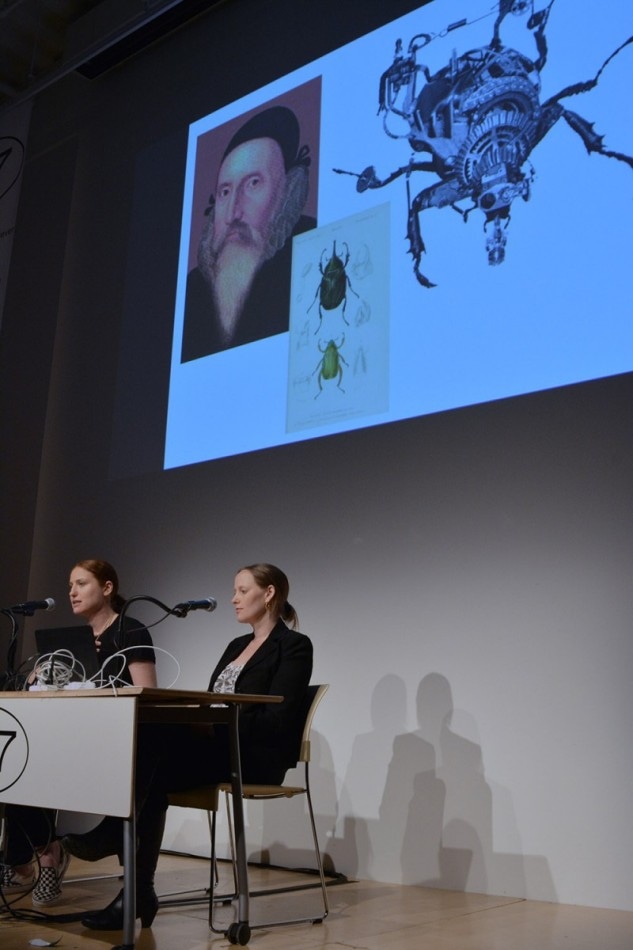May 2 2019
At times, people transform when they work collectively. One such instance is single-celled slime mold, which takes on completely new characteristics as a group. Another instance is a researcher and an artist working together on a museum event, integrating their individual tendencies toward the basic and the abstract.
 Kirstin Petersen, assistant professor of electrical and computer engineering, right, with artist Rachel Rose, April 27 at the New Museum in New York City, presenting art inspired by Petersen’s research on swarm robots. (Image credit: Mitch Sawyer/New Museum and Rhizome)
Kirstin Petersen, assistant professor of electrical and computer engineering, right, with artist Rachel Rose, April 27 at the New Museum in New York City, presenting art inspired by Petersen’s research on swarm robots. (Image credit: Mitch Sawyer/New Museum and Rhizome)
I have trained my brain to think a certain way. I work in a very goal-oriented manner within the confines of physics.
Kirstin Petersen, Assistant Professor, Electrical and Computer Engineering, Cornell University
Petersen was chosen to work with artist Rachel Rose for Seven on Seven, a program that teams up artists with technologists and presents them the challenge of developing something new.
“Rachel showed me a very abstract piece of art, and I said, ‘I’m sorry, my engineering brain does not wrap around this,” Petersen stated. “And then she started explaining, and we started debating, and I think now we have converged on something that touches on the very foundation of our fields.”
Petersen and Rose exhibited their project—a sequence of collages developed by Rose, with Petersen discussing the robotics technology that motivated them—on April 27 at the New Museum in New York City. They were chosen and paired up by the coordinators of the event, which is produced by Rhizome, a new media arts team that is an affiliate-in-residence at the New Museum.
Collages of Rose were based on swarm robots that are, in turn, dependent on the characteristic of slime mold. Petersen’s Collective Embodied Intelligence Lab concentrates on simple robotic systems motivated by biology. Swarm robots are collectives made up of several elementary parts that are quite easy and inexpensive to create, and can work together to carry out difficult and complicated operations.
The individual amoebae in slime mold cannot perform much by themselves. However, when in a group, the organisms can form a shape that can move much faster through its environment, and arrange into a fruiting body that disperses spores to breed in new regions.
“We have these incredibly simple creatures that together can exhibit an immensely intelligent behavior,” Petersen said. “It is the ultimate form of altruism—some will be sacrificed and die, but the rest survive, so how do they decide who gets to survive and why? That’s the amazing complexity that emerges from these systems.”
The robots that are being developed by her group—which weigh below 30 g and have magnets to repel and attract each other into shapes—may finally be able to correspond with the survival abilities of the slime mold.
Because our robots are flexible, they can interact safely with their environment and survive physical perturbations. We are developing software to make these robots able to evaluate their collective health. For example, identifying which one is low on power or under the highest amount of strain. They’re going to have to reason about how to collaborate to stay alive, and when it makes sense to give up some modules for the greater good.
Rachel Rose, Artist
Rose was fascinated by this idea, Petersen stated.
“Rachel saw this and she got very excited, and she said, ‘OK, well, first of all on a high level, you have these swarms and you’re adding more and more artificial intelligence to them,” she stated. “As we do that, every individual robot is no longer the same robot. They all have different histories and opinions. So to her, it’s interesting to think that over time they might differentiate, and you suddenly have different robots with their own personalities.
That can affect the swarm in different ways. They would sense and reason about their environment differently. And then what do you do? It’s a whole new level of complexity.
Kirstin Petersen, Assistant Professor, Electrical and Computer Engineering, Cornell University
The artwork by Rose focuses on this complexity, including complete images of what the robots, collectively, might eventually turn out to be. “It’s design at a very abstract level,” stated Petersen. “It was very interesting to see the ideas this prompted.”